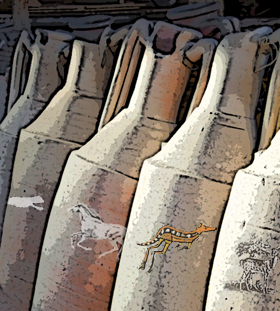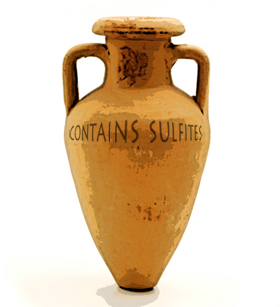Pain & Sulfuring.
Contrary to public opinion, wineries didn’t start adding sulfites to wine in 1987. That’s simply the year the US government dictated all wine containing more than 10 ppm, the smallest detectable amount at the time, be labeled with the warning “contains sulfites.”¹ If a winery can produce wine with less than 10 ppm of detectable sulfites they can forgo the warning label. I’ve sold organic wine for years and only once have I seen a label that read, “contains no detectable sulfites”. It may have been a misprint as the label should have read, “contains no detectable flavor”.
The warning label only applies to wines sold in America, leading many consumers to mistakenly believe that just those bottles destined for America are adulterated with sulfur while their European counterparts remain sulfite-free. The European Union has recently instituted a similar sulfur warning label so the idea that they are sulfite-free should soon be exposed as a myth – just like the idea that vampires can’t go out in daylight (like, have you even seen Twilight?).
Burning sulfur has been used to preserve food and wine since ancient times. In the Bible, sulfur is referred to as brimstone, and we all know what happened to Sodom and Gomorrah when God introduced them to fire and brimstone. Homer mentioned the curative powers of burning sulfur in The Odyssey, Pliny wrote of its medicinal virtues, and the Romans burned sulfur inside barrels before filling them with wine over a thousand years ago. This practice, still in use today, permeates the barrel while consuming oxygen, effectively suffocating any microscopic Sodom and Gomorrah colonies that could corrupt the wine. Even with this pervasive sulfur use, archeologists have yet to unearth any ancient amphora bearing Latin sulfur warnings. They have however, found several adorned with cute animal labels.
 The first “official” approval of sulfur use in wine production dates back to a 1497 German decree, but commercial use began in earnest in 18th century Bordeaux, which may explain why the wines of Bordeaux are so long-lived. Without sulfur, all of those renowned wine cellars would be filled with expensive salad dressing.
The first “official” approval of sulfur use in wine production dates back to a 1497 German decree, but commercial use began in earnest in 18th century Bordeaux, which may explain why the wines of Bordeaux are so long-lived. Without sulfur, all of those renowned wine cellars would be filled with expensive salad dressing.
Sulfur’s primary role is to ward off unwanted micro-organisms. Bacteria and certain hooligan yeast organisms could wreak havoc during wine production if not for a sulfite intervention. Oxidation, unacceptable acidity levels, brown coloration, short shelf life, effervescence, off-flavors and aromas are a few of the flaws we would have to contend with if not for sulfur’s curative properties.
Sulfites occur naturally in all wine because they are a byproduct of fermentation and are prevalent in and around vineyards and wineries, just like fruit flies, dot-com millionaires and other obnoxious pests.
These trace amounts of sulfur aren’t enough to cure all the ills inherent in wine production, so most of the sulfites found in wine are added by the winemaker at various stages of production. Wines that have excessive sulfur added can have a smell reminiscent of a burnt match or rotten eggs. If you are sensitive to sulfur you may experience a short-lived, but sharp pain in your sinuses when you inhale sulfurous gas from a freshly opened bottle of wine. More serious is the concern of asthmatics, as sulfites have been known to trigger asthma attacks. Letting the wine breathe and aggressive swirling can help relieve the bad gas odors, which may explain why I often find my wife aggressively shaking me in my sleep.
Another myth surrounding sulfites is the belief that they cause headaches. Andrew L. Waterhouse, Professor of Enology, University of California at Davis emphatically writes, “There is no medical research data showing that sulfites cause headaches!”² Do you get headaches from fruit juices, fruit concentrates, jams, pizza dough, frozen potatoes, or salad bars? E coli maybe, headaches probably not. These foods all contain sulfites, often in higher levels than those found in wine. Kathy Patalsky, author of the vegan cookbook Healthy Happy Vegan Kitchen writes, “Two ounces of dried apricots have 10 times the sulfites as a glass of wine. Eating dried apricots is a great way to test your allergic reaction to sulfites.”³ There are many other suspects that may cause wine headaches – histamines, tannins, prostaglandins, tyramine and let’s not forget alcohol or the obnoxious date you’re out with – but sulfites are not the culprit.
Wines can be produced without the addition of sulfur, but the process is difficult and could have adverse effects on the quality of the wine. A winery producing “no sulfites added” wine must be kept sterile to keep unwanted organisms to a minimum. Pasteurization can be performed as well as micro-filtration to eliminate any microbial troublemakers, but even with these precautionary measures,“no sulfites added” wines have a shorter shelf life than other wines. The expense, short shelf life and quality concerns of these procedures make them unfeasible for large-scale commercial wine production and undesirable to most small wineries.
Sulfites have always been in wine. They were there when Jesus turned water into wine at a poorly planned wedding in Cana, and they were there when you drank that heavenly Brunello in Tuscany (and still felt great the next day). And sulfites are present in wine even when they’re not present on a warning label. The Sancerre or Chianti you enjoyed in Europe is the same wine you enjoyed when you returned to New Jersey. That rotten egg aroma you detect is just the breeze from Camden.
¹ The law wasn’t enacted until 1988.
² “Sulfites.” UC Davis,University of California, Waterhouse Lab 2012 http://waterhouse.ucdavis.edu/whats-in-wine/sulfites-in-wine
³ “Debunking Ten Sulfite Myths.” HappyHealthyLife.com Jan. 06, 2009 http://kblog.lunchboxbunch.com/2009/01/debunking-ten-sulfite-myths.html






















Thank you for the quote and link. Love your website! As a fellow wine-lover I think I need to start browsing some of your articles! 🙂
Your quote about apricots was perfect so I chose it over more scientific quotes from Homer’s blogsite. Plus Pliny’s tweets didn’t quite fit and Pliny the Elder just doesn’t have a good grasp of technology!